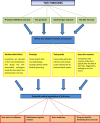Harm or protection? The adaptive function of tick toxins
- PMID: 33664774
- PMCID: PMC7896703
- DOI: 10.1111/eva.13123
Harm or protection? The adaptive function of tick toxins
Abstract
The existence of tick toxins is an old enigma that has intrigued scientists for a long time. The adaptive value of using deadly toxins for predatory animals is obvious: they try to kill the prey in the most effective way or protect themselves from their natural enemies. Ticks, however, are blood-sucking parasites, and it seems paradoxical that they have toxins similar to spiders, scorpions and snakes. Based on published data, here we examine the potential adaptive function of different types of toxins produced by soft and hard ticks. We hypothesize that there are diverse evolutionary roles behind (a) to attack and reduce the tick-transmitted pathogens inside the vertebrate host systemically to protect the tick, (b) to paralyse the host to stop grooming, (c) to speed up host heartbeat to improve blood supply and (d) to inhibit the process of necroptosis to prevent the rejection of hard ticks. We will provide published evidence that supports the above-mentioned hypotheses, and we will give an outlook how these new scientific results might be applied in modern pharmacology and medicine.
Keywords: adaptive function; antimicrobial effect; necroptosis; protease inhibitors; soft and hard ticks; tachycardia; tick paralysis; tick toxins.
© 2020 The Authors. Evolutionary Applications published by John Wiley & Sons Ltd.
Conflict of interest statement
None declared.
Figures
Similar articles
-
The deep-rooted origin of disulfide-rich spider venom toxins.Elife. 2023 Feb 9;12:e83761. doi: 10.7554/eLife.83761. Elife. 2023. PMID: 36757362 Free PMC article.
-
Tick Paralysis: Solving an Enigma.Vet Sci. 2018 May 14;5(2):53. doi: 10.3390/vetsci5020053. Vet Sci. 2018. PMID: 29757990 Free PMC article. Review.
-
Biochemical perspectives on paralysis and other forms of toxicoses caused by ticks.Parasitology. 2004;129 Suppl:S95-111. doi: 10.1017/s0031182003004670. Parasitology. 2004. PMID: 15938507 Review.
-
Rickettsial and other tick-borne infections.Crit Care Nurs Clin North Am. 2007 Mar;19(1):27-38. doi: 10.1016/j.ccell.2006.11.001. Crit Care Nurs Clin North Am. 2007. PMID: 17338947 Review.
-
A list of the 70 species of Australian ticks; diagnostic guides to and species accounts of Ixodes holocyclus (paralysis tick), Ixodes cornuatus (southern paralysis tick) and Rhipicephalus australis (Australian cattle tick); and consideration of the place of Australia in the evolution of ticks with comments on four controversial ideas.Int J Parasitol. 2014 Oct 15;44(12):941-53. doi: 10.1016/j.ijpara.2014.08.008. Epub 2014 Sep 16. Int J Parasitol. 2014. PMID: 25236960 Review.
Cited by
-
Molecular Identification of Hyalomma Ticks and Application of Bacillus thuringiensis Toxins as an Effective Biological Acaricide.J Parasitol Res. 2024 Sep 11;2024:9952738. doi: 10.1155/2024/9952738. eCollection 2024. J Parasitol Res. 2024. PMID: 39296814 Free PMC article.
-
Tick paralysis induced by Ixodes gibbosus: enigmatic cases in domestic mammals from Cyprus.Front Vet Sci. 2024 Jun 6;11:1416501. doi: 10.3389/fvets.2024.1416501. eCollection 2024. Front Vet Sci. 2024. PMID: 38903693 Free PMC article.
-
Bulk and single-nucleus RNA sequencing highlight immune pathways induced in individuals during an Ixodes scapularis tick bite.Infect Immun. 2023 Nov 16;91(11):e0028223. doi: 10.1128/iai.00282-23. Epub 2023 Oct 17. Infect Immun. 2023. PMID: 37846980 Free PMC article.
References
-
- Bowman, A. S. , & Nuttall, P. A. (2004). Ticks: Biology, Disease and Control. Cambridge, UK: Cambridge University Press.
LinkOut - more resources
Full Text Sources
Miscellaneous


